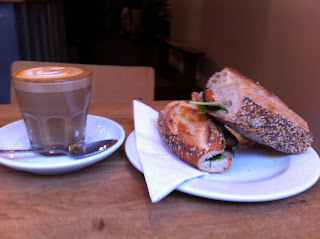Children in restaurants are a controversial topic.
In my bit of East London, they are pretty much everywhere -- I even spotted a sleeping baby at an open mic night in the basement of a local cocktail bar. In places with a different demographic they can be less welcome.
I wouldn't take mine to, say, the Fat Duck, Le Gavroche or the local old man's boozer. But in a cafe in the daytime, I reckon it's fair game. A girl has to eat, after all.
As someone who's never been a huge fan of (other people's) children, I am, however, very self conscious about taking the baby places and perhaps have an overactive imagination when it comes to public disapproval.
So it's possible that the hostility I felt in Notes in Covent Garden was entirely my own perception -- maybe the server was just having a bad day -- but I felt it acutely nonetheless.
It looked much like any other modern cafe: coffee in small glasses, a large wooden bar/counter and posh-looking sandwiches for around a fiver each. A later, closer inspection revealed aspirations for higher things with bottles of wine and a (presumably trendy) music shop downstairs.
The guy behind the counter glanced at me and the pushchair with about as much enthusiasm as at the homeless guy who walked in before me. To be fair, the baby was on the grumpy side.
There wasn't much in the way of a detailed food menu, possibly because the offerings change regularly. I would have liked more information, more detailed answers to my questions about the fare on offer on the counter. Like to be told that the sausage rolls weren't just the ordinary kind, but pork and apple. I would have ordered them then. Or to be given the option of having some salad with the sandwich I hastily chose in the end, as other customers were later (admittedly by a different server). As I say, it could have been my imagination, but the guy seemed pretty impressed when I said I was eating in. He did offer to bring my coffee and sandwich to me (I don't know if this is what they normally do), but in the end this just meant I ended up having to queue a second time in order to pay (resisting the urge to sneak out).
When he appeared with the order, I asked if I could also have a mandarinade, which I'd spotted on the board in the meantime, and which had intrigued me. He said yes, but this never appeared, even though there was a lull in customers while I was eating.
The sandwich was nice -- silky, salty goats cheese with velvety aubergines and the sweet tang of (I think) onion marmalade. It was a little over-peppered though, and some cutlery would have been nice to scoop up the filling and cut through the crusty bread. The coffee was fine, but the entire experience left a bit of a sour taste. Back in the fresh air, I continued towards Covent Garden, stumbling on the bustling Real Food Market, which I discovered to be a regular Thursday occurrence. I wish I'd eaten there instead.
Notes could be a good place for music, and you could definitely do worse if you are looking for a quick bite or drink in the area, but I'd give it a miss if you are with a baby.
Notes could be a good place for music, and you could definitely do worse if you are looking for a quick bite or drink in the area, but I'd give it a miss if you are with a baby.
Notes, 36 Wellington St, Covent Garden, WC2E 7BD; Tel. 02072407899; www.notesmusiccoffee.com


























